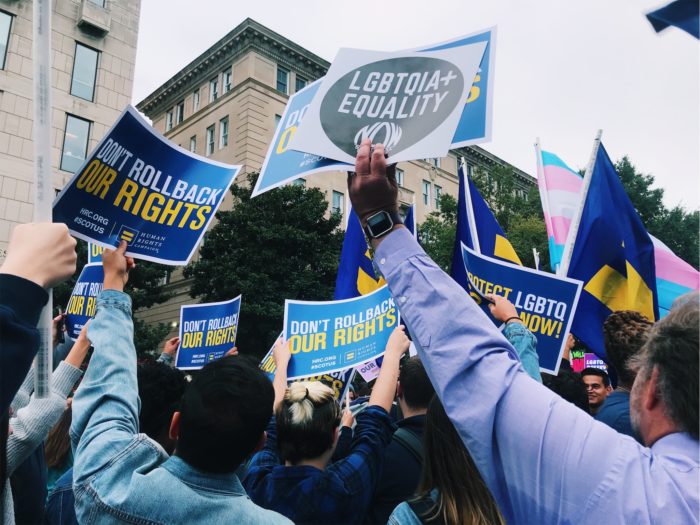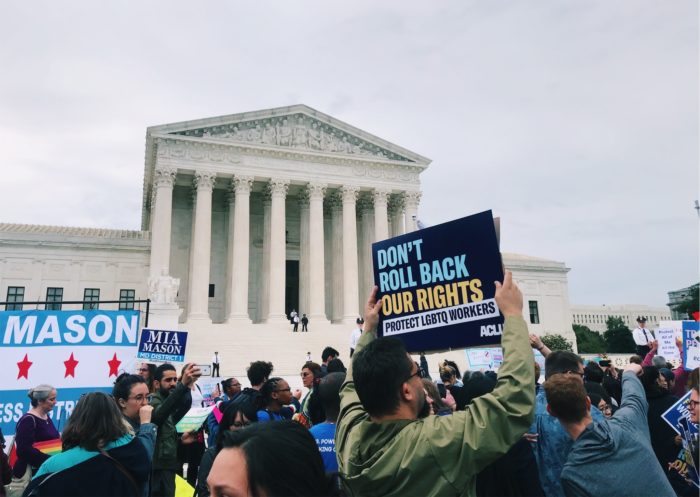
Last month–LGBT History Month–on October 8, the Supreme Court heard three cases regarding LGBTQ discrimination in the workplace. To show support for those representing the cases and the LGBTQ community generally, and to demonstrate the will of the people, a protest was held outside the Supreme Court. A few key moments stood out to me, especially compared to the 2018 March for Our Lives, my only protest for reference.
I won’t forget the moment the organization Faith for Equality came out in the middle of the crowd: a group of people wearing denominational clothing and carrying signs that read “Faith for Equality” and “My faith does not discriminate” walked slowly to the center of the crowd, singing the lyrics “this little light of mine, I’m gonna let it shine.” Their singing breaking through the nervous chatter of the people was so comforting. After they had finished their group song, they introduced themselves one by one. People of all different religions had come together to show their support for the LGBTQ community and promote love and human rights. A few hateful protesters loomed on the block across the street, holding derogatory signs. But when they started playing music over a speaker, the leaders of Faith for Equality weren’t phased. Instead, they insisted that we all started singing again, but louder, to drown them out.
Eventually the protest moved in front of the Supreme Court, where the image of rainbow-colored flags proudly waving in front of the columns made me feel like what I was doing was important. People handed out shirts, rainbow heart stickers, and rainbow flags to anyone who wanted them. The atmosphere changed from a rallying spirit to more fun and celebratory.
I had posted numerous pictures of the protest throughout the day when I got a text from my friend. She said that she felt a lot of feelings about the day’s cases and the protest, but the main thing she felt was that she wanted to say thank you for being an ally who was there when she couldn’t be.
The entirety of my experience that day left me thinking about how to be an ally to the LGBTQ community. I want to show support and give people the platform to speak, not simply showing up when it is not my place. I know that as a heterosexual, cisgender woman, I can not fully know the struggles of those in the LGBTQ community. I wasn’t sure if I should be holding the rainbow flags that people were handing me. There’s a way to be an ally and there are ways not to, and I am always trying to be cognizant of being respectful. (I am also aware that by saying all of this, there is irony that I am speaking on the subject as someone who is not a member of the community. However, I am attempting to speak to fellow allies–and those wanting to be allies–about how we can be the best allies we can be.)
For example: allyship and Pride events. The general rule of thumb that I, and many others, follow is that a straight, cisgender person can go to Pride if they are accompanying as an ally. Pride is about the LGBTQ people in your life, and about them being proud of who they are; Pride is not for “allies” who, more often than not, are there to appear trendy and post pictures online. Attending Pride oftentimes becomes a competition for attaining acknowledgment (or more informally, cookies) for allyship, which is not what being an ally is about.
The first step of any social justice movement is being aware of the people around you and their needs. While Pride may have started as a protest, for the most part, it isn’t anymore. A protest like the one outside of the Supreme Court–a protest about equal protection under the law–relies on turnout to gain traction. In this case, showing up is a huge part of showing support. Knowing when and where your presence is needed as an ally is part of allyship.
While the plight of straight, cis women is not the same as the plight of LGBTQ people, a thought that grounds me in figuring out my allyship is how I would want men to behave at a political march specifically for women: if a man showed support for the women’s movement by giving women the platform to speak, that is a respectful demonstration of being an ally. If a straight and/or cisgender person goes to a protest in support of LGBTQ equality, being respectful and acknowledging the reason they are there are only the first few steps of being an ally.

However, there’s no single way to be an ally and people will disagree on what limits and expectations exist (although explaining to other straight people that no, we do not need a straight Pride parade, is a good place to start). What is important to carry through, however you choose to be an ally, is to recognize that allyship is putting yourself on the line and inherently doing more than what is convenient. For any further steps, there are a few options. First, ask your LGBTQ friends how you can best be an ally. There are also resources online (a couple are linked below!) available to help navigate your allyship to the LGBTQ community.
How to be an ally to your LGBT friends, relatives, and co-workers
